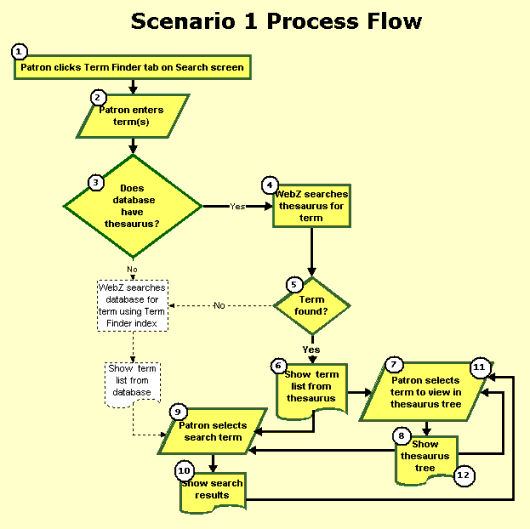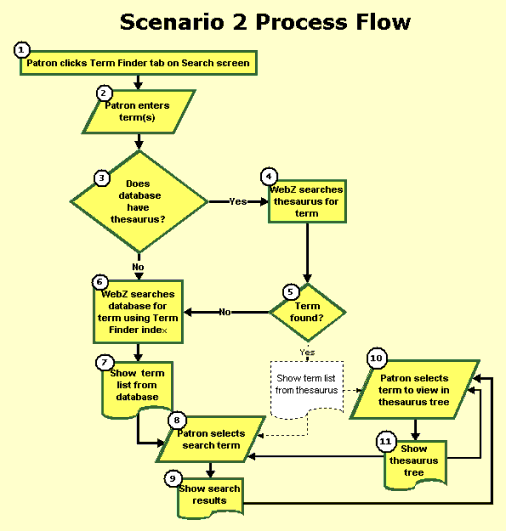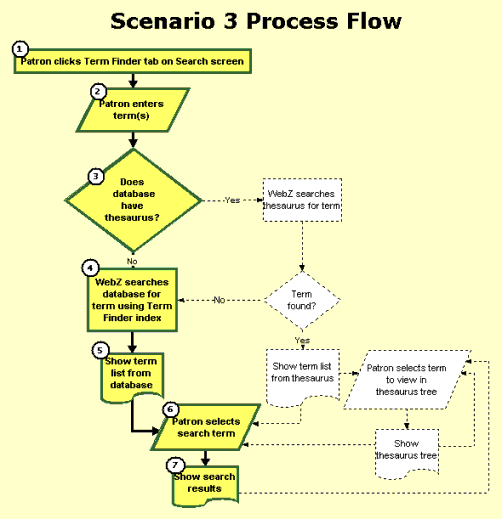Introduction
This topic illustrates vocabulary-assisted searching in the WebZ Out-of-the-Box Interface (OBI), version 1, by tracing the process flow in three scenarios where vocabulary-assisted searching is enabled for a particular database:
- Scenario 1: Database is associated with a thesaurus database and the search term exists in the thesaurus
- Scenario 2: Database is associated with a thesaurus database but the search term does not exist in the thesaurus
- Scenario 3: Database is not associated with a thesaurus database
There is one process flow diagram for vocabulary-assisted searching, but each scenario takes a different path through the process flow. To differentiate between the possible paths, the steps that apply to each scenario are numbered, shaded, and shown in bold text.
There are links in
each scenario (labeled go to example
![]() ) that
display screen diagrams from
Vocabulary-Assisted Searching in the WebZ
Out-of-the-Box Interface (OBI)
topic, which uses the same scenarios used in this topic. When you click
one of these links, a second browser window opens with the appropriate
graphic at the top of the browser window. You can click either the text
link or the icon to see the graphic).
) that
display screen diagrams from
Vocabulary-Assisted Searching in the WebZ
Out-of-the-Box Interface (OBI)
topic, which uses the same scenarios used in this topic. When you click
one of these links, a second browser window opens with the appropriate
graphic at the top of the browser window. You can click either the text
link or the icon to see the graphic).
| Note: | All HTML files described in this topic reside in the directory <WebZ_root>/htdocs/obiv1/html/, where <WebZ_root> is the location of your SiteSearch environment. |
Scenario 1: Database is associated with a thesaurus database and the search term exists in the thesaurus

| Step | Action |
|---|---|
| 1 | The patron clicks the Term Finder tab on the database's Search screen (search.html). |
| 2 | WebZ
displays a Term Finder search screen (termfindersearch.html). The
patron enters one or more search terms (go
to example |
| 3 | WebZ's TermFinderQuery verb (ORG.oclc.obi.extverb.TermFinderQuery) determines that the database has a thesaurus by reading information about the database in the JaSSI. TermFinderQuery is a specialized QUERY verb for retrieving term list information. |
| 4 | The TermFinderQuery verb submits a query for the search term(s) against the database's thesaurus using the thesaurus database's Main Term index. |
| 5 | One or more records in the thesaurus satisfy the query. The TermFinderQuery verb issues a FETCH command to retrieve these records. The formatting class ORC.oclc.fmts.rules.SaveTermFinderResults extracts the data needed to build a term list from these records and creates a map (hashtable) to hold this data. |
| 6 | WebZ
formats the term list, using the formatting display specification
for the thesaurus's term list (specified in the thesaurus's database
configuration file), and displays it for the user on termlist.html,
the term list screen (go
to example |
| 7 | The patron selects one of the terms in the list to see it in the context of a thesaurus tree with broader, narrower, and related terms. The class ORG.oclc.obi.extverb.ThesaurusQuery retrieves the record for the term by submitting a query against the thesaurus's Main Term Phrase index. The class ORC.oclc.fmts.rules.SaveTermFinderResults creates maps (hashtables) to hold the record retrieved for the thesaurus tree. |
| 8 | WebZ
displays the thesaurus tree (thestree.html) (go
to example |
| NOTE: The patron can repeat steps 7-8 as needed to see the thesaurus tree for other terms. | |
| 9 | The patron selects one or more terms from the thesaurus tree to search the database. |
| 10 | WebZ
executes the patron's search, using the index specified in the database's
configuration file for searches from a term list, and displays the
results on the brief search results screen (brief.html) (go
to example |
| 11 | The patron clicks the tree icon to display the thesaurus tree for a particular subject. |
| 12 | WebZ
displays the thesaurus tree for the selected subject (thestree.html)
(go
to example |
Scenario 2: Database is associated with a thesaurus database but the search term does not exist in the thesaurus

| Step | Action |
|---|---|
| 1 | The patron clicks the Term Finder tab on the database's Search screen (search.html). |
| 2 | WebZ
displays a Term Finder search screen (termfindersearch.html). The
patron enters one or more search terms (go
to example |
| 3 | WebZ's TermFinderQuery verb (ORG.oclc.obi.extverb.TermFinderQuery) determines that the database has a thesaurus by reading information about the database in the JaSSI. TermFinderQuery is a specialized QUERY verb for retrieving term list information. |
| 4 | The TermFinderQuery verb submits a query for the search term(s) against the database's thesaurus using the thesaurus's Main Term index. |
| 5 | There are no records in the thesaurus that satisfy the query. |
| 6 | The TermFinderQuery verb now searches the target database using its Term Finder search index (specified in the database's configuration file) using the term(s) the patron entered on the Term Finder screen. TermFinderQuery then retrieves the records with a FETCH command. The formatting class ORC.oclc.fmts.rules.SaveTermFinderResults extracts the data needed to build a term list from these records and creates a map (hashtable) to hold this data. |
| 7 |
WebZ formats
the term list, using the formatting display specification for the
database's term list (specified in the database's configuration
file) and displays it for the user (termlist.html) (go
to example The gadget ORG.oclc.gadgets.TermFinderHeader builds the header with the search box and database name. The gadget ORG.oclc.gadgets.TermListDisplay builds the term list. The items in the term list come from subject fields of a sample of records returned in response to the search using the database's Term Finder search index. The number of records to sample is specified in the database's configuration file. The size of the term list is not necessarily the same as the number of records sampled. First, each record may have multiple subjects. Second, the SaveTermFinderResults class removes duplicate entries when it extracts data from the records for the term list. Third, the search to retrieve records for the term list may yield fewer records than the sample size. |
| 8 | The patron selects one or more search terms from the term list to search the database. |
| 9 | WebZ
executes the patron's search, using the Term List search index specified
in the target database's configuration file, and displays the results
on the brief results screen (brief.html) (go
to example |
| 10 | The patron clicks the tree icon to display the thesaurus tree for a particular subject. |
| 11 |
WebZ displays
the thesaurus tree (thestree.html) (go
to example Each term shown includes the number of postings ("hits") for the term in the target database. The number of hits for each term results from a behind-the-scenes search of the database, using the index specified in the database's configuration file for searches from term lists. The ThesTreeDisplay gadget executes this search. |
Scenario 3: Database is not associated with a thesaurus database

| Step | Action |
|---|---|
| 1 | The patron clicks the Term Finder tab on the database's Search screen (search.html). |
| 2 | WebZ
displays a Term Finder search screen (termfindersearch.html). The
patron enters one or more search terms (go
to example |
| 3 | WebZ's TermFinderQuery verb (ORG.oclc.obi.extverb.TermFinderQuery) determines that the database does not have a thesaurus by reading information about the database in the JaSSI. TermFinderQuery is a specialized QUERY verb for retrieving term list information. |
| 4 | The TermFinderQuery verb (ORG.oclc.obi.extverb.TermFinderQuery) submits a query for the search term(s) in the database. The query uses the Term Finder search index specified in the database's configuration file. TermFinderQuery then retrieves the records with a FETCH command. The formatting class ORG.oclc.fmts.rules.SaveTermFinderResults extracts the data needed to build a term list from these records and creates a map (hashtable) to hold this data. |
| 5 |
WebZ formats
the term list, using the formatting display specification for the
database's term list (specified in its database configuration file)
and displays it for the user (termlist.html) (go
to example The gadget ORG.oclc.gadgets.TermFinderHeader builds the header with the database name and the search box. The gadget ORG.oclc.gadgets.TermListDisplay builds the term list. The items in the terms list come from subject fields of a sample of records returned in response to the search against the database's Term Finder search index. The number of records to sample is specified in the database's configuration file. The size of the term list is not necessarily the same as the number of records sampled. First, each record may have multiple subjects. Second, SaveTermFinderResults removes duplicate entries when it extracts data from the records for the term list. Third, the search to retrieve records for the term list may yield fewer records than the sample size. |
| 6 | The patron selects one or more search terms from the related terms list to use in a database search. |
| 7 | WebZ
executes the patron's search, using the Term List search index specified
in the database's configuration file, and displays the results on
the brief results screen (brief.html) (go
to example |
See Also
WebZ
and Vocabulary-Assisted Searching
Configuring Databases to Use Vocabulary-Assisted Searching with its Thesaurus
Database
Configuring Databases to Use Vocabulary-Assisted
Searching without a Thesaurus Database
Database Configuration Files
Term List Formatting Configuration Files
Thesaurus Formatting Configuration Files
Vocabulary-Assisted Searching in the WebZ
Out-of-the-Box Interface